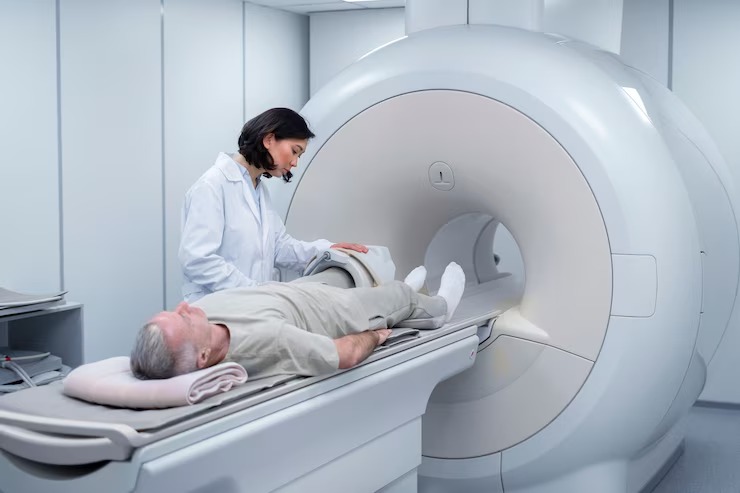Blogs
- Home /
- Blogs
What Is Radiosurgery and How Does It Work?
Radiosurgery is a medical treatment that uses targeted radiation to treat certain conditions, especially tumors or abnormal growths, without the need for a scalpel or traditional surgery. Dr. Nilesh Potdar, a renowned specialist in this field, has been helping many patients through this non-invasive and effective procedure. By using advanced technology, radiosurgery offers a safe and precise way to treat conditions such as brain tumors, spinal tumors, and other abnormalities without causing significant damage to the surrounding healthy tissues.
The concept of radiosurgery may sound complicated, but it is actually a relatively simple procedure that involves focusing high doses of radiation on a specific area. This technique allows doctors to target even the smallest or hard-to-reach tumors without the need for open surgery.

How Does Radiosurgery Work?
Radiosurgery works by delivering powerful radiation beams to a precise location inside the body, where a tumor or abnormal tissue is located. The radiation disrupts the DNA of the target cells, which causes them to stop growing or die. Over time, this radiation shrinks or eliminates the tumor. The procedure is non-invasive, meaning no cuts or incisions are needed, and it’s usually done on an outpatient basis, meaning patients can go home the same day.
Here’s how the process works in simple steps:
- 1. Planning and Imaging: Before the actual treatment, doctors use advanced imaging technologies like MRI, CT scans, or PET scans to locate the tumor and map its exact position. These images help the medical team plan the most effective and accurate path for the radiation beams.
- 2. Positioning the Patient: During the procedure, the patient is positioned in a specialized machine that is designed to deliver radiation. The patient is usually asked to lie down comfortably, and the machine may be adjusted to focus precisely on the treatment area.
- 3. Radiation Delivery: Once everything is in place, the machine delivers a concentrated beam of radiation to the tumor. The radiation may be delivered from multiple angles to ensure it reaches the target area while minimizing exposure to healthy tissues.
- 4. Post-Treatment Monitoring: After the treatment, the patient is typically monitored for a short period to make sure they are recovering well. Some patients may experience mild side effects like fatigue or swelling, but these are generally temporary.
Types of Radiosurgery
There are different types of radiosurgery methods, depending on the equipment used and the area being treated. The two most common types are:
- 1. Gamma Knife Radiosurgery: This is the most commonly used radiosurgery method for brain-related issues. It uses 201 beams of highly focused gamma radiation to treat brain tumors, arteriovenous malformations (AVMs), and other brain disorders. The patient’s head is typically fitted into a frame to keep it still during the procedure.
- 2. CyberKnife Radiosurgery: Unlike Gamma Knife, CyberKnife can be used to treat a variety of tumors in different parts of the body, including the brain, spine, lungs, liver, and prostate. This method uses a robotic arm to deliver radiation from many angles, making it highly flexible and precise.
Both methods are extremely effective at treating tumors and other abnormal tissues with minimal discomfort for the patient.
Benefits of Radiosurgery
There are several advantages to choosing radiosurgery over traditional surgery, including:
- • Non-invasive: No need for incisions, stitches, or general anesthesia, reducing the risk of infection and recovery time.
- • Precise Treatment: Advanced technology allows doctors to target the tumor very precisely, sparing surrounding healthy tissue from damage.
- • Outpatient Procedure: Most radiosurgery treatments are performed on an outpatient basis, meaning the patient can go home the same day.
- • Minimal Recovery Time: Since the procedure does not involve cutting into the body, recovery is faster and less painful.
- • Effective for Hard-to-Reach Tumors: Radiosurgery can treat tumors located in areas that are difficult to access through traditional surgery.
Who Can Benefit from Radiosurgery?
Radiosurgery is suitable for many patients, including those who:
- • Have tumors that are not operable or located in hard-to-reach areas.
- • Are not healthy enough to undergo traditional surgery.
- • Are seeking an alternative to open surgery.
- • Have smaller or early-stage tumors that can be effectively treated with radiation.
It’s important to note that radiosurgery is not always the best option for every patient or every type of tumor. A consultation with a medical expert like Dr. Nilesh Potdar can help determine if radiosurgery is the right choice based on the individual’s condition and medical history.
Side Effects of Radiosurgery
While radiosurgery is a safe and well-tolerated procedure, some patients may experience mild side effects. These can include:
- • Fatigue
- • Mild swelling or irritation at the treatment site
- • Nausea or headaches (especially if treating brain tumors)
- • Skin redness (in cases where the radiation is applied close to the skin)
Most of these side effects are temporary and resolve within a few weeks after treatment.
Conclusion
Radiosurgery is a groundbreaking treatment option that offers a non-invasive, precise, and effective solution for treating tumors and other abnormalities. With the help of skilled experts like Dr. Nilesh Potdar, many patients have successfully undergone this treatment with minimal discomfort and recovery time. Whether you're dealing with brain tumors, spinal tumors, or other conditions, radiosurgery could be the key to improving your health without the need for traditional surgery.
If you're considering radiosurgery or have questions about whether it's right for you, it’s important to book a consultation with a medical expert. Book now to learn more about how radiosurgery could help you or a loved one on the path to better health.

